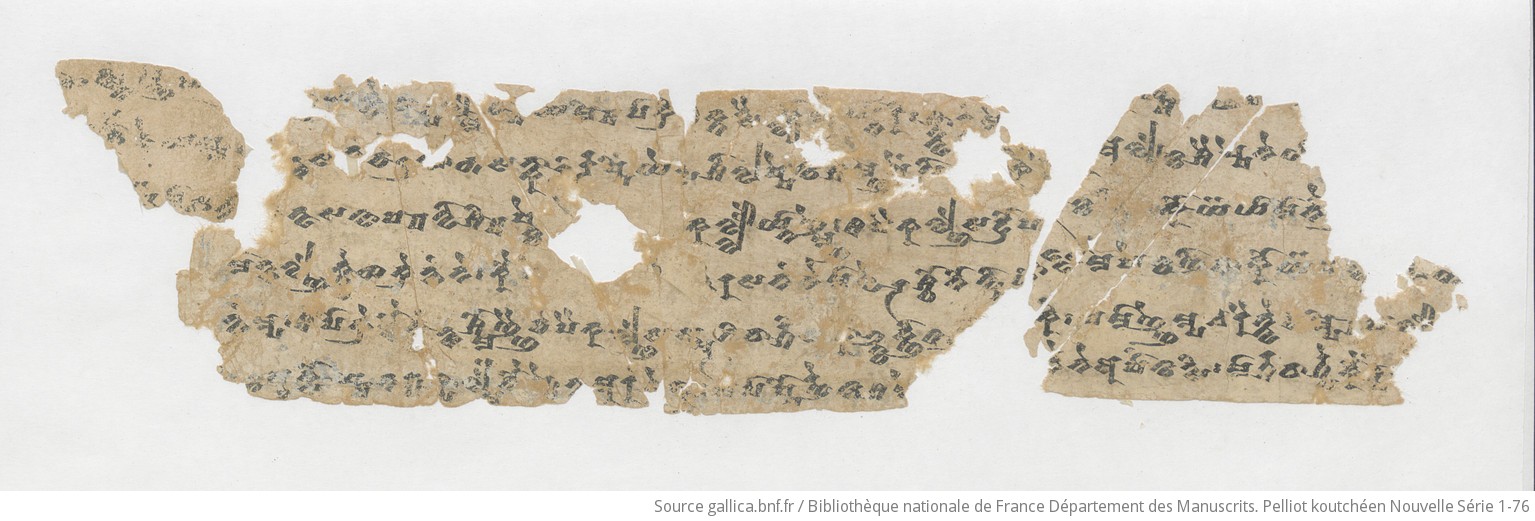| a1 | (– – –) [k]a y[ä] kne sa śp· lm[eṃ] ñ[i]¯ ¯ś ya mi¯ ¯m pā kri [o] kta tsai klyo m[ñ]ai ytā ri : śtwā re m· ·e /// ai śa mñe ṣṣeṃ ā stre śne po ka llo [ye] /// |
|---|
| a2 | (– –) ¯ts sa naṃ ce¯ ¯u lā bha sa tkā¯ ¯r• rra ṣṣiṃ ye ts· śī la ṣṣe ai śa mñe ṣ·eṃ mī /// (·)[s](·) [r]au ñe ṣṣe kau ṣnā ya o mpa lsko ṣṣe /// |
|---|
| a3 | (– –) tū sa au ṣa¯ ¯p wī śi¯ ¯m ṣe¯ ¯k ○ ka llau ynā ñmñe : 20 pai ka lñe sa dro ha /// kñī ta¯ ¯rñä se rkeṃ [ne] po cme la (·)[e] /// |
|---|
| a4 | mā nta lñe kuce¯ ¯s̝ kre ntaṃ ne : kau [ṣ]· ○ ntai ra sa naṃ ne mā we¯ ¯r śco no wṣī [ñä] /// t[r]a ṅko : a knā tsai mpa ṣe [ś]· /// |
|---|
| a5 | ntaṃ mpa : 20-1 po kre ntau naṃ¯ ¯ts śmo ññai ce pai ka lñe sa smṛ ti vā¯ ¯rg[ä] sa kā¯ ¯lk kñi ta[¯] [¯rñä] /// [e] lai kne nta po ka r[s]o /// |
|---|
| a6 | [ṣe]¯ ¯k ā kso¯ ¯ym ta rya śpā lmeṃ nau mye nta a raṃ śne e ṅ[ku] : pa pā ṣṣo rñe ai śa m(·)e /// – [ṣ](·)(·) (·)e [:] 20 2 pra /// |
|---|
| b1 | ā ksau tā ko¯ ¯yñ[ä] : [i] m· ṣṣ[a] n· ṣa rn· [s]· pa· ·[o]¯ ¯ym y· kweṃ y· llo· ṣṣeṃ [w]· /// ñ(·)(·) ṣ(·) ṣa [r]ma – /// |
|---|
| b2 | – rka rmeṃ ltu me ñe ra y[ai]¯ ¯m a sta re 20 3 pai ka lñe sa uda ka vā¯ ¯rgä po e kṣa lyi[ṃ] [po] /// ññe sā¯ ¯k pa ṣṣī m(·) [r]a /// |
|---|
| b3 | ts[e] r[a] kra ñī we o ro tsñe sa meṃ [ṣ]ī ○ ma¯ ¯r ynau ṣka¯ ¯k skā yo¯ ¯ymä : lyka śke[ṃ] ra /// ṅka ṣṣi¯ ¯m ka rtsau ñe¯ ¯ś /// |
|---|
| b4 | (– –) ma kte kro ṅśaṃ¯ ¯ts cä ñca rñe pya ○ pyaiṃ wa rssi : tū sa au ṣa¯ ¯p mai yyā ts[t]·e /// [ts]a ṅko yñi a kā¯ ¯lk rma mñe : ś[ī] /// |
|---|
| b5 | (– –) ce yā mo rsa : sa pū le mpa me nā ktā ka rso¯ ¯ym ke ktse¯ ¯ñä kau tā ts[ai] /// [5] [pai] ka lñe sa a śva vā¯ ¯rgä co laṃ ya /// |
|---|
| b6 | (– – –) [y]ya [s]a ke [ke] – [ñi¯] [¯ś] ṣe ktā ko¯ ¯ym po c[m]e la ne : ai [ś]· [mñ]· ṣṣ[e] sā ra thiṃ ka /// – nai śai yā ta ṣṣi ta¯ ¯rñä : pe lai kne ·e /// |
|---|
| a1 | In this way indeed may I make manifest the excellent eightfold noble path. Through the seeing of the four truths may all obtain the pure eyes of wisdom. 19. |
|---|
| a1+ | (I have written the Satkāravarga) [understanding] this gain [and] pride (= Skt. lābha-satkāra-) as the enemy of (all the virtues). |
|---|
| a2 | He [= the enemy] tears out the skin of moral behavior [and] (he cuts into small pieces the whole me)at of wisdom. He breaks the bones of the energy [and] (he cooks the marrow) of meditation (completely. |
|---|
| a2+ | Like the snake with sharp venom), even more than that, may I avoid always gain [and] pride. |
|---|
| a3 | 20. Through the writing of the Droha(varga may) my (wish) come true in the circles of all births. |
|---|
| a3+ | (May I not feel) anger (towards an evil person, even an angry one), and even less towards good people. |
|---|
| a4 | Even towards a murderous enemy may hate [and] enmity not reside in me (at all [and] may I abandon) the sin. (May I not have a) m(eeting) with an ignorant one |
|---|
| a4+ | ([and] may I come together) with go(od people). |
|---|
| a5 | 21 Through the writing of the Smṛtivarga, this fondation of all virtues, may my wish come true. (By consciousness directed towards the body may I) understand all qualities [= dharma], (each by its own mark.) |
|---|
| a5+ | May I always awake (the good awakening) having seized in the heart the three excellent jewels. |
|---|
| a6 | (May I not forget) the observance, the wisdom, (the meditation, without making ha)rm. 22 (I have written) the Pra(kīrṇakavarga) ... |
|---|
| a6+ | ... may it be told by me! |
|---|
| b1 | May I stretch the horses of the sense functions with the two hands of consciousness! ... the cause ... |
|---|
| b1+ | like the moon coming out from [behind] the clouds I went [through as a] pure [one]. |
|---|
| b2 | 23. Through the writing of the Udakavarga (may I attend) all the feasts of omni(science) ... May I observe the zeal through ... |
|---|
| b2+ | May I (not) be sorrowful because of the greatness like the ... |
|---|
| b3 | may I strive as always. May I reject every evilness even a small one, ... the goodness! (24. |
|---|
| b3+ | I have written the Puṣpavarga:) |
|---|
| b4 | As it is the pleasure of bees to smell flowers, may the wish [and] the inclination (towards all virtues) be more powerfull than that! |
|---|
| b4+ | (With the pure smell of the good cond)uct [= śīla] (may all the beings become) (decorated) through this deed! |
|---|
| b5 | May I understand this body [as being] fragile, somewhat like a pot, [and] may (I) not cling [to it]! 25. Through the writing of the Aśvavarga (may I tame) the fierce ho(rses of the sense functions)! |
|---|
| b5+ | May I myself be always provided with the (fo)rce (of patience) in all births! |
|---|
| b6 | (May I o)btain the chariot driver of the wisdom, (the excellent one,) may he tame me (ac)curately, [being] (resolute) in the Law ... |
|---|
| * | In b6 there are four signs missing between the fragments of the same leaf, in b5 seven, b4 five, b3 six, b2 nine, b1 = ?. |
|---|
| n1 | Instead of the plural aiśamñeṣṣeṃ the parallel text PK AS 4A a 5 has the correct dual form aiśamñeṣṣi. |
|---|
| n2 | The parallel text PK AS 4A b 2 has ñiś instead of ṣek. |
|---|
| n3 | The parallel text PK AS 4A b 3 has the phrase with sandhi krentäṃmp= eṣe, which makes the complete last colon. Either we have a mistake here or again a different wording. |
|---|
| n4 | The parallel text PK AS 5B a 3 has menāk ksa instead of menāk tā. |
|---|
| n6 | Note that the parallel PS Uv 67 a 5 seems to have the locative sg. . |
|---|
| n7 | akalk\ has a small virama stroke. |
|---|
Lévi, Sylvain. 1933. Fragments de textes koutchéens. Udānavarga, Udānastotra, Udānālaṁkāra et Karmavibhaṅga, publiés et traduits avec un vocabulaire et une introduction sur le «tokharien». Paris: Imprimerie Nationale.






